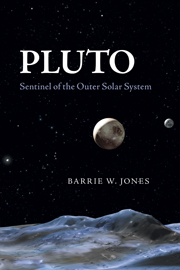Book contents
- Frontmatter
- Contents
- List of tables
- Preface
- Acknowledgements
- 1 The Solar System
- 2 The discovery of Uranus, Neptune and Pluto
- 3 Pluto: a diminishing world
- 4 Pluto's family
- 5 Surfaces, atmospheres and interiors of Pluto and Charon
- 6 The Edgeworth-Kuiper belt
- 7 Is Pluto a planet?
- 8 The New Horizons mission to Pluto (and beyond)
- 9 Pluto: gateway to beyond?
- Glossary
- Further reading and other resources
- Index
5 - Surfaces, atmospheres and interiors of Pluto and Charon
Published online by Cambridge University Press: 05 December 2011
- Frontmatter
- Contents
- List of tables
- Preface
- Acknowledgements
- 1 The Solar System
- 2 The discovery of Uranus, Neptune and Pluto
- 3 Pluto: a diminishing world
- 4 Pluto's family
- 5 Surfaces, atmospheres and interiors of Pluto and Charon
- 6 The Edgeworth-Kuiper belt
- 7 Is Pluto a planet?
- 8 The New Horizons mission to Pluto (and beyond)
- 9 Pluto: gateway to beyond?
- Glossary
- Further reading and other resources
- Index
Summary
So far, I've said very little about the surfaces and atmospheres of Pluto and its satellites, and for interiors I've given only the mean global densities and a broad indication of global compositions. In this chapter the compositions will be discussed in more detail, and internal models will be introduced.
I start with surfaces and atmospheres, which are clearly of intrinsic interest, but also because they provide clues and constraints about the interiors of Pluto and Charon. Very little is known about Nix and Hydra, therefore almost nothing is said here about these tiny satellites.
In Chapter 6 you will see that what we learn about Pluto and its satellites helps us to learn about other objects in the outer Solar System, notably the Kuiper belt objects.
First, some basic science. How do we obtain information about the surfaces and atmospheres of distant bodies? The answer is through measuring their albedos (reflectivities), which has already been discussed in Section 3.1, and by measuring their electromagnetic reflection and emission spectra.
REFLECTION AND EMISSION SPECTRA
The albedo of a body gives us information averaged over a wide range of wavelengths in solar radiation, particularly visible wavelengths. The reflectance spectrum is the reflectivity versus wavelength, and provides much more detailed information about a body. A reflectance spectrum is obtained with a device called a spectrometer, the essential components of which are illustrated in a simple way in Figure 5.1.
- Type
- Chapter
- Information
- PlutoSentinel of the Outer Solar System, pp. 112 - 145Publisher: Cambridge University PressPrint publication year: 2010



